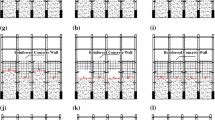Abstract
The subway system plays a vital role in reducing the traffic congestion problems in urban cities. Recently, a number of underground railway transportation networks are commissioned and opened for operation or are being constructed in many cities in India. Metro station excavations is a tough task and pose threat to public safety, due to high intricacy and uncertainty in excavation activities. The stability of deep excavation and adjacent buildings has gained highlighted concerns during metro station construction. The underground metro station under study is located in Anna Salai Road, Chennai, India. The station is located at the centre of the main street. The project comprised of three basement levels. It has a length of 240 m and a width of 19–22 m at the track level. The excavation depth is about 18.0 m. The entire site is located within a floodplain. The performance of the deep excavation and adjacent area were monitored using extensive instruments. Monitored data are analyzed and presented as a case study in this paper.
Access this chapter
Tax calculation will be finalised at checkout
Purchases are for personal use only
Similar content being viewed by others
References
Weng, Q., Xu, Z., Zhihou, Z., & Liu, Ruobiao. (2016). Design and performance of the deep excavation of a substation constructed by top-down method in Shanghai soft soils. Procedia Engineering, 165, 682–694. https://doi.org/10.1016/j.proeng.2016.11.766.
Ran, L., Ye, X. W., & Zhu, H. H. (2011). Long-term monitoring and safety evaluation of a metro station during deep excavation. Procedia Engineering, 14, 785–792. https://doi.org/10.1016/j.proeng.2011.07.099.
Arshad, & Abdullah, R. A. (2016). A review on selection of tunnelling method and parameters effecting ground settlements. Electronic Journal of Geotechnical Engineering, 21(14), 4459–4475.
Paul, V. K., Khursheed, S., & Singh, R. (2017). Comparative study of construction technologies for underground metro stations in India. nternational Journal of Research in Engineering and Technology, 6(3), 55–63.
Vasagavijayan, S., & Ooi, C. E. (2015). Instrumentation and monitoring of underground works for KVMRT. In Proceedings of International Conference on Tunnelling and Underground Space.
Rastogi, V. K. (2008). Instrumentation and monitoring of underground structures and metro railway tunnels. In World Tunnel Congress, India.
Clough, G. W., O’Rourke, T. D. (1990). Construction induced movements of in-situ walls. In Design and performance of earth retaining structures (Vol. 25, pp. 439–470). Geotechnical Special Publication ASCE.
Author information
Authors and Affiliations
Corresponding author
Editor information
Editors and Affiliations
Rights and permissions
Copyright information
© 2019 Springer Nature Singapore Pte Ltd.
About this paper
Cite this paper
Muhammad Ramees Ali, T.M., Rajasekaran, C. (2019). Performance of Deep Excavation for an Underground Metro Station Constructed by Top-Down Method—A Case Study. In: Das, B., Neithalath, N. (eds) Sustainable Construction and Building Materials. Lecture Notes in Civil Engineering , vol 25. Springer, Singapore. https://doi.org/10.1007/978-981-13-3317-0_54
Download citation
DOI: https://doi.org/10.1007/978-981-13-3317-0_54
Published:
Publisher Name: Springer, Singapore
Print ISBN: 978-981-13-3316-3
Online ISBN: 978-981-13-3317-0
eBook Packages: EngineeringEngineering (R0)




